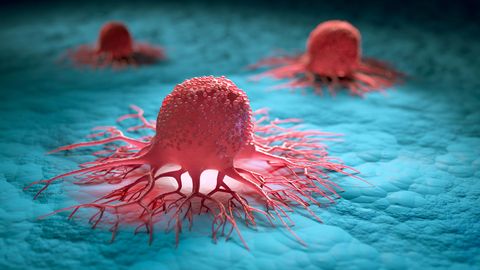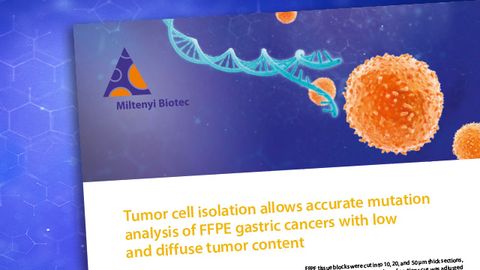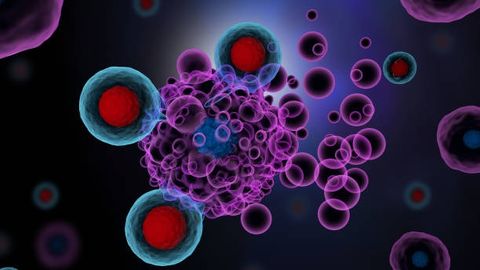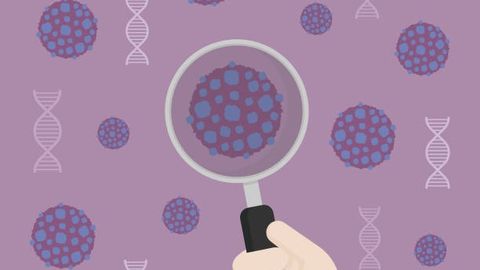Cell-to-Cell Communication in Cancer
Communication between tumor-causing cells and other cells supports several processes necessary for tumor development and distribution.
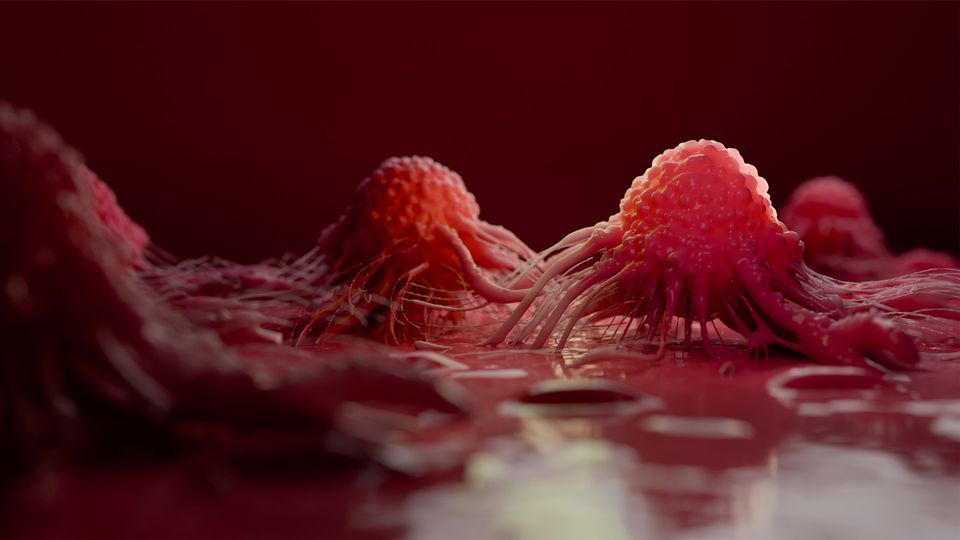
Complete the form below to unlock access to ALL audio articles.
The body is made up of trillions of cells constantly adjusting to their environment and exchanging millions of signals essential for survival. Their communication must be carefully controlled because any disruption can result in mistakes, such as the abnormal proliferation of cells we see in cancer.1
We typically think of a cancerous tumor as a bunch of abnormal cells gone rogue – cells that have rapidly and uncontrollably multiplied because their cell signaling pathways have gone awry. However, the situation is more complicated; these cells communicate with each other and other cells in their environment and work together in a strategic fashion.2
This article will explore cell-to-cell communication’s role in cancer development, its influence on metastasis and how research is expanding our knowledge of the disease.
What is cell-to-cell communication?
“Essentially, cell-to-cell communication describes how cells interact with each other to maintain a state of homeostasis or normality,” explains Dr. Eric Rahrmann, senior research associate at Cancer Research UK’s Cambridge Institute. “It’s much like a conversation between people where a cell engages another cell by sending out signals or physical interactions and the receiving cell responds to this signal. For example, a cell could secrete a peptide and the neighboring cell receives the signal, interprets and actions it. The process is essential in normal human development and functioning, especially in differentiation and specialization of cells such as stem cells.”
“Cells communicate with each other in many ways, including secreting hormones that bind to receptors in neighboring cells and through direct contact with each other’s surfaces,” adds Dr. Stuart S. Martin, professor of pharmacology at the University of Maryland School of Medicine and deputy director and associate director of basic research at the Marlene and Stewart Greenebaum Comprehensive Cancer Center. “These signals and contacts determine cell growth, cell death and cell differentiation.”
In cancer, cell-to-cell communication is corrupted by cells miscuing and sending out signals that allow a self-serving environment to be created, evading the cues of cell-to-cell communication. “If cell A has a mutation and no longer responds to signals from cell B, it can grow exponentially and create a tumor,” Rahrmann explains.
Cell-to-cell communication has a critical role in tumor development and evolution as it enables cancer cells to reprogram the surrounding tumor microenvironment – and cells located elsewhere. Communication between tumor-causing cells and other cells supports several processes necessary for tumor development and distribution such as angiogenesis, immune escape, invasion and multi-drug resistance.
This communication may be via membrane receptors and ligands or via soluble molecules like growth factors, cytokines and chemokines. Additionally, microRNAs and extracellular vesicles have recently been identified as additional means of cell communication. Circulating microRNAs are often deregulated in many cancers and, and as they affect all the disease’s hallmarks, they may be good biomarkers for cancers, while extracellular vesicles released from cancerous cells contribute to tumor growth and distribution.3
Cell-to-cell communication and metastasis
Metastasis occurs when cancer cells break away from their original location and travel via the bloodstream to set up camp in other organs in the body like the lungs, bone, brain or liver. Metastasis is the leading cause of death from cancer, explains Martin: “The original tumor almost never causes the patient to die. Instead, when these cancer cells form new tumors in the distant organs, these new metastatic tumors are what causes patient death.”
“The process of metastasis is actually very inefficient and the cancerous cells undergo many changes to survive their journey and be successful in their new environment,” says Rahrmann. “Communication enables the process to become more efficient in many ways, for example, tumor cells may partner with neutrophils, a type of white blood cell in the immune system, to create a pro-tumor environment.”
Tumor cells sometimes migrate together, like an island moving through the bloodstream with its own microenvironment, searching for a new site. These cells change how they communicate with non-cancerous cells – vasculature or immune cells for example – to enable their survival. “Cell induction creates signals which change and support the tumor cells rather than normal cells,” Rahrmann explains.
Migrating tumor cells are known as circulating tumor cells or CTCs, and work in the past decade has revealed that when they cluster together, their ability to successfully form metastatic tumors is up to 50 times higher. “Cell-to-cell communication between the tumor cells in the CTC cluster can help the tumor cells survive the harsh environments they encounter during metastasis,” says Martin.
“In the bloodstream, CTCs face strong physical pressures of flow and constriction as well as immune cell attack. In the distant tissues, the growth environment is very different than the original tissues, so many CTCs will die or stop growing permanently. CTCs in a cluster gain protection from the cell-to-cell communication, to both survive in the bloodstream and successfully regrow in the distant organ,” he continues.
Martin’s lab focuses on rapidly testing patient tumor cells for metastatic behaviors, rather than growth. “In this way, we can determine within a few hours which drugs can potentially reduce the risk of metastasis most effectively for the specific cells from that patient's tumor,” explains Martin. His team developed a microfluidic technology that can test small amounts of patient tumor cells recovered from needle biopsies or blood samples. “We can determine multiple metastatic behaviors in these tumor cells within a few hours, and whether specific drug treatments can reduce the metastatic activity in these cells and lower the risk of metastasis,” Martin says.
Cancer’s ability to metastasize has also been linked to the electrical activity of cells, and research has demonstrated prostate cancer cells’ ability to alter their baseline voltage to open sodium ion channels in their membranes. This channel can be opened by cancer cells to let in ions that make them more likely to metastasize; closing the channel could be a way to stop it from happening.2
Conversely, Rahrmann et al. have identified that the loss of function of sodium leak channel non-selective protein (NALCN) in gastrointestinal cancers promotes metastatic disease by enhancing the release of CTCs. By viewing metastasis as a “normal phenomenon” rather than something unique to cancer, they found that NALCN regulates both normal and cancerous epithelial cell dissemination, divorcing the process of metastasis from cancer.4
“These normal disseminated epithelial-like cells can ‘metastasize’ to distant organs, but instead of making tumors, they contribute to apparently normal structures in these tissues such as kidney tubules,” Rahrmann says. “For this to occur, seeded circulating epithelial-like stem cells must communicate with neighboring cells in their new environment to mimic or adapt to a new cell state.”
Research is changing the face of cancer treatment
Research has changed the way we think about cancer, and therefore how we approach treating it. Now we know that different parts of the tumor signal to each other to coordinate growth, blocking their conversation could pave the way for new treatment strategies.
Additionally, tumor cells can mask themselves, tricking the immune system into thinking they are “normal” cells, says Rahrmann: “Tumor cells engage with receptors that mask the tumor; they adopt the tissue’s features to make it look like they belong. Cell-to-cell communication allows the tumor cell to engage with normal cells, allowing them to exist. There are huge ongoing efforts to disrupt cells masking as normal cells and reveal their identity. For example, small molecule inhibitors are being used to block the masking signal, let the immune system recognize them and inhibit the activity of tumor cells.”
Rahrmann notes several types of immunotherapies that are useful in treating cancer, including monoclonal antibody therapies designed to recognize specific proteins on cancer cells, just like the body would. It hijacks cell-to-cell communication so drug therapies can be released into the tumor and kill the disease; examples include trastuzumab and rituximab, which work in different ways to kill cancer cells or stop them from growing.5
Another is CAR T-cell therapy, a type of adoptive cell transfer, which involves harvesting a patient’s immune cells and teaching them to identify and target tumor cells. A receptor designed to recognize and target a specific protein on the cancer cells is added to the immune cells and, once administered back to the patient, these cells kill the tumor.6
Future treatments will continue to be aimed at blocking cell-to-cell communication, Martin says, and there are already several existing therapies used to treat breast cancer. These include selective estrogen receptor modulators (SERMS) like tamoxifen or raloxifene, which block the estrogen signals that help breast cancer cells grow, as well as aromatase inhibitors like letrozole, anastrozole and exemestane, which block estrogen production.
“These drugs are already important tools to block cell-to-cell communication in breast cancer, and hopefully serve as a model to develop similar cell-to-cell communication targeting,” he says.
Other research is focused on metastasis as there are “very few drugs that target these metastatic steps and limited options for following the process of metastasis more carefully in patients,” Martin says. “This is where new methods for detecting cancer in patients through liquid biopsies and new imaging methods in animal models of cancer can help identify critical steps for stopping metastasis.”
Current research is also helping to reveal important limitations of our existing and previous methods, Martin adds: “For example, current clinical imaging can only detect a tumor once it reaches a size of between 10 million and 100 million cells. As an inevitable result, the methods for monitoring patients and developing new cancer treatments have focused on reducing the growth of very large tumors.”
As cancer evolves and evades treatment, therapies and treatment must also change, and new research, particularly on cell-to-cell communication, is teaching us more and more about how to treat and manage this devastating disease.
About the interviewees:
Dr. Eric Rahrmann is a senior research associate in the laboratory of Professor Richard Gilbertson at Cancer Research UK (CRUK) - Cambridge Institute (within the University of Cambridge) and training director for CRUK Cambridge Cancer Centre Brain Cancer Virtual Institute. The group aim to improve the accuracy of brain tumor classification and treatment.
Dr. Stuart S. Martin is a professor of pharmacology at the University of Maryland School of Medicine and deputy director and associate director of basic research at the Marlene and Stewart Greenebaum Comprehensive Cancer Center. His lab is working to apply engineering and physical sciences to improve the understanding of cancer metastasis.
References
1. ‘We need to talk’: how and why cells communicate and what happens when things go wrong. Babraham Institute. Published March 18, 2022. Accessed 8th December 2023. https://www.babraham.ac.uk/blog/how-do-cells-communicate
2. Owens J. Understanding Cell-to-Cell Communication in Cancer. Technology Networks. Published August 1, 2023. Accessed 8th December 2023. https://www.technologynetworks.com/tn/articles/understanding-cell-to-cell-communication-in-cancer-375894
3. Chiodoni C, Di Martino MT, Zazzeroni F, et al. Cell communication and signaling: how to turn bad language into positive one. J Exp Clin Cancer Res. 2019;38(1):128. doi: 10.1186/s13046-019-1122-2
4. Rahrmann EP, Shorthouse D, Jassim A, et al. The NALCN channel regulates metastasis and nonmalignant cell dissemination. Nat Genet. 2022;54(12):1827-1838. doi: 10.1038/s41588-022-01182-0
5. Monoclonal Antibodies (MABs). Cancer Research UK. Accessed 8th December 2023. https://www.cancerresearchuk.org/about-cancer/treatment/targeted-cancer-drugs/types/monoclonal-antibodies
6. CAR T-cell therapy. Cancer Research UK. Accessed 8th December 2023. https://www.cancerresearchuk.org/about-cancer/treatment/immunotherapy/types/CAR-T-cell-therapy

